Tupolev Tu-16 Videos
|
Loading...
|
|
Tupolev Tu-16
Tu-16
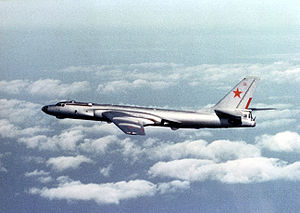
Picture - Tu-16R "Badger-E"
Role: Strategic bomber
Manufacturer: Tupolev
First flight: 27 April 1952
Introduced: 1954
Retired: 1993 (in former Soviet Union nations)
Status: Xian H-6 in service
Primary users: Soviet Air Force
Egyptian Air Force
Indonesian Air Force
Iraqi Air Force
Number built: 1,509
Variants: Tupolev Tu-104
Tupolev Tu-124
Xian H-6
The Tupolev Tu-16 (NATO reporting name: Badger) was a twin-engine jet bomber used by the Soviet Union. It has flown for more than 50 years and the Chinese license-built Xian H-6 remains in service with the Chinese air force.
Development
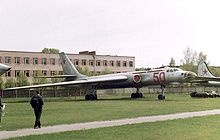
Picture - Tu-16 bomber at the Monino Museum.
In the late 1940s the Soviet Union was strongly committed to matching the United States in strategic bombing capability. The Soviets' only long-range bomber at the time was Tupolev's Tu-4 'Bull', a reverse-engineered version of the American B-29 Superfortress. The development of the extremely powerful Mikulin AM-3 turbojet led to the possibility of a large, jet-powered bomber.
The Tupolev design bureau began work on the Tu-88 ("Aircraft N") prototypes in 1950. The Tu-88 first flew on 27 April 1952. After winning a competition against the Ilyushin Il-46, it was approved for production in December 1952. The first production bombers entered service with Frontal Aviation in 1954, receiving the service designation Tu-16. It received the NATO reporting name 'Badger-A'.
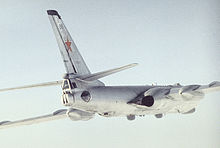
Picture - Rearside view of a Tu-16 Badger reconnaissance variant (most likely Tu-16R).
It had a new, large swept wing and two large Mikulin AM-3 turbojets, one in each wing root. It could carry a single massive FAB-9000 9,000-kg (19,800 lb) conventional bomb (the Russian equivalent of the British Grand Slam bomb) or various nuclear weapons to a range of around 4,800 km (3,000 mi).
Although the Tu-16 began as a high-altitude, free-fall bomber, in the mid-1950s it was equipped to carry early Soviet cruise missiles. The Tu-16KS-1 ('Badger-B') version could carry AS-1 'Kennel' missiles over a combat radius of 1,800 km (1,125 mi). These very large weapons were aerodynamically similar to the MiG-15 'Fagot' fighter, fitted with either a nuclear or conventional warhead, had a range of about 140 km (90 mi). They were intended for use primarily against US Navy aircraft carriers and other large surface ships. Subsequent Tu-16s were converted to carry later, more advanced missiles, while their designations changed several times.
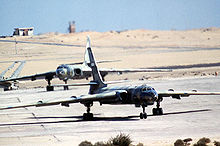
Picture - Egyptian Tu-16s.
A versatile design, the Tu-16 was built in numerous specialized variants for reconnaissance, maritime surveillance, electronic intelligence gathering (ELINT), and electronic warfare (ECM). A total of 1,507 aircraft was constructed in three plants in the Soviet Union, in 1954-1962. A civilian adaptation, the Tu-104 'Camel', saw passenger service with Aeroflot. The Tu-16 was also exported to Egypt, Indonesia, and Iraq. It continued to be used by the Air Forces and naval aviation of the Soviet Union and subsequently Russia until 1993.
Delivery of the Tu-16 to China began in 1958, and the Xi'an Aircraft Industrial Corporation (XAC) produces a copy of it under the Chinese designation Xian H-6. At least 120 of these aircraft remain in service.
Variants
Among the main production variants of the Badger were the Tu-16 and Tu-16A bombers; Tu-16KS and Tu-16K-10 missile carriers; Tu-16SPS, "Elka", and Tu-16Ye ECM aircraft; Tu-16R reconnaissance aircraft; and Tu-16T torpedo bomber; others were produced from conversions. Individual aircraft could be modified several times, with designations changed, especially concerning missile-carrying aircraft.
Badger A (Tu-16) - This the basic configuration of the Tu-16 bomber deployed in 1954 to replace the Tu-4. Several modified models of these variant existed, all of which were known as Badger A in the West.
Tu-16A - Modified Tu-16s designed to carry nuclear bombs, one of main versions, with 453 built. Many of those units were subsequently converted into other variants.
Tu-16Z - An early specialized version of the Tu-16 that served as airborne tankers (a refuelling method: wing-to-wing), though they retain their medium bomber role.
Tu-16G (Tu-104G) - Fast air mail model, Aeroflot aircrew training version.
Tu-16N - A dedicated tanker version for Tu-22/Tu-22M bombers, with probe and drogue system. Entered service in 1963. Similar aircraft Tu-16NN converted from Tu-16Z.
Tu-16T - Limited production maritime strike version (torpedo bomber), that served in the Soviet Naval Aviation, and carried torpedoes, mines and depth charges. 76 built and some more converted. All units subsequently converted into Tu-16S configuration.
Tu-16S - A lifeboat carrier version used for search and rescue operations.
Tu-16Ye - These were equipped with heavy electronic warfare and electronic intelligence (ELINT) equipment.
Badger B (Tu-16KS) - Variant designed as a launch platform for two AS-1 Kennel/KS-1 Komet missiles. 107 built in 1954-1958, served with the Soviet Naval Aviation, Egypt and Indonesia. Soviet ones later converted with newer missiles.
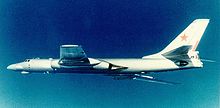
Picture - Tu-16K-10-26 Badger C
Badger C (Tu-16K-10) - Another Naval Aviation variant, units of this version carried a single AS-2 Kipper/K-10S anti-ship missile. 216 built in 1958-1963. It differed from other variants having a radar in a nose. A further development, the Tu-16K-10-26, carried a single K-10S and two KSR-2 or KSR-5 AS-6 Kingfish missiles (K-26 missile complex). Some were later converted into ELINT platforms.
Badger D (Tu-16RM-1) - Maritime reconnaissance model with ELINT equipment; 23 converted from Tu-16K-10. It retained its radar in a nose and could guide K-10S missiles, fired from other planes, at targets.
Badger E (Tu-16R) - Reconnaissance version of the airframe, with ELINT equipment, first of all meant for maritime reconnaissance. It could guide KS missiles.
Tu-16RM-2 - modified Tu-16R, serving in the Naval Aviation. It could guide KSR-2 missiles.
Tu-16KRM - Launch platforms for target drones (a variant of Tu-16K-26).
Badger F (Tu-16RM-2) - Another reconnaissance version based on the -16R/RM but with the addition of external ELINT equipment.
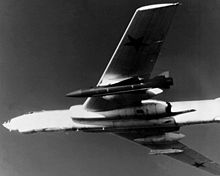
Picture - Tu-16 Badger G with KSR-5 missile
Badger G (Tu-16K/Tu-16KSR) - Serving in the Naval Aviation, these were conversions from earlier models. These were designed to carry bombs in internal bays in addition to carrying air-to-surface missiles externally, such as the AS-5 Kelt and AS-6 Kingfish. There existed numerous variants, designated either from carried missile complex (K-11, K-16 and K-26) or from missiles of these complexes (KSR-11, KSR-2 and KSR-5). Following further modifications, they were also given suffixes. Main variants:
Tu-16KSR-2 - carrying the K-16 complex (two KSR-2 missiles). Used from 1962. Similar aircraft, converted from other variants, were designated Tu-16K-16.
Tu-16K-11-16 - carrying the K-16 complex (KSR-2 missiles) or the K-11 complex (two anti-radar KSR-11 missiles). Used from 1962. Similar aircraft were designated Tu-16KSR-2-11. Over 440 Tu-16 could carry the K-16 or K-11 complex.
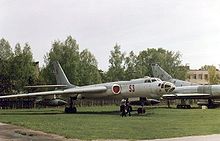
Picture - Tu-16K-26 or Tu-16KSR-2-11-16, with KSR-5 missiles under wings
Tu-16K-26 - carrying the K-26 complex (two KSR-5 missiles), retaining a capability of KSR-2 and 11 missiles. Used from 1969. Similar aircraft were designated Tu-16KSR-2-5-11 or Tu-16KSR-2-5 (no KSR-11 capability). Over 240 Tu-16 could carry the K-26 complex.
Tu-16K-26P - carrying the K-26P missiles (two anti-radar KSR-5P missiles, as well as KSR-5, 2 or 11).
Badger H (Tu-16 Elka) - Designed for stand-off electronic warfare and electronic counter-measures support.
Badger J (Tu-16P Buket) - Another electronic warfare variant configured as an ECM strike escort.
Badger K (Tu-16Ye) - Believed to be a version of the Badger F configuration possessing enhanced ELINT capability.
Badger L (Tu-16P) - Another version of the Badger J with more modern systems and used in ELINT role.
Operators
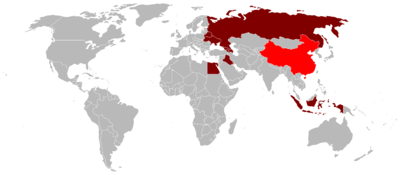
Picture - Current operators of the Tu-16/H-6 in bright red, former operators in dark red
Armenia
Armenian Air Force : 30 aircraft inherited from the Soviet Union. Out of service by 1995.
Azerbaijan
Azerbaijan Air Force : 10 aircraft inherited from the Soviet Union. Out of service by 1995.
Belarus
Belarus Air Force : 121 aircraft inherited upon the fall of the Soviet Union , out of service by 1995.
People's Republic of China
People's Liberation Army Air Force : A few Tu-16s were acquired in 1959; the type was then built under license as the Xian H-6
People's Liberation Army Navy Air Force
Egypt
Egyptian Air Force : Operated Tu-16KS, Tu-16T, Tu-16KSR-2-11, and Tu-16R. Also operated H-6. Last retired in 2000.
Georgia
Georgian Air Force : 20 aircraft inherited from the Soviet Union. Out of service by 1995.
Indonesia
Indonesian Air Force : 26 Tu-16KS-1 acquired in 1961. Used during the preparation of Operation Trikora in 1962, the taking of Western New Guinea from the Netherlands (now Papua and Papua Barat). They were also planned for attacking the Colossus class aircraft carrier, HNLMS Karel Doorman. All were based at Iswahjudi Air Base, Madiun, East Java, and were grounded in 1969. No longer in service since 1970.
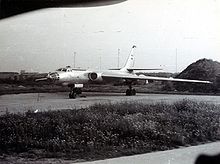
Picture - Iraqi Tu-16
Iraq
Iraqi Air Force : Eight Tu-16, six Tu-16KSR-2-11. Also operated H-6. All destroyed in Operation Desert Storm in 1991.
Russia
Russian Air Force : Many aircraft inherited from the Soviet Union. Out of service by 1993.
Russian Naval Aviation
Soviet Union
Soviet Air Force
Soviet Naval Aviation
Ukraine
Ukrainian Air Force : 18 aircraft inherited from USSR. All retired from service.
Specifications (Tu-16)
General characteristics
Crew: 4
Length: 34.80 m (114 ft 2 in)
Wingspan: 33.00 m (108 ft 3 in)
Height: 10.36 m (34 ft 0 in)
Wing area: 165 m (1,780 sq ft)
Empty weight: 37,200 kg (82,012 lb)
Gross weight: 76,000 kg (167,551 lb)
Max takeoff weight: 79,000 kg (174,165 lb)
Powerplant: 2 x Mikulin AM-3 M-500 turbojets, 93.2 kN (21,000 lbf) thrust each
Performance
Maximum speed: 1,050 km/h (650 mph; 570 kn)
Range: 7,200 km (4,474 mi; 3,888 nmi)
Service ceiling: 12,800 m (41,995 ft)
Wing loading: 460 kg/m² (94 lb/ft²)
Thrust/weight: 0.24
Armament
Guns: 6-7 x 23 mm Nudelman-Rikhter NR-23 cannons, two each in dorsal and ventral remote turrets and manned tail turret, with the occasional addition of one fixed forward in the nose
Missiles:
2 x Raduga KS-1 Komet (AS-1 Kennel) anti-ship missile on underwing hardpoints or
1 x Raduga K-10S (AS-2 Kipper) anti-ship missile semi-recessed in bomb bay or
2 x Raduga KSR-5 (AS-6 Kingfish) anti-ship missile on underwing hardpoints
Bombs: 9,000 kg (20,000 lb) of free-fall weapons or
Related development
Xian H-6
Tupolev Tu-104
Tupolev Tu-124
Comparable aircraft
B-47 Stratojet
Vickers Valiant
Handley Page Victor
Avro Vulcan
Footnotes
Bibliography
Russian Strategic Nuclear Forces,edited by Pavel Podvig, The MIT Press, 2001.
Soviet Military Power: 1983, 1984, 1986, 1987, 1988
ТÑ-16. РакеÑно-бомбовÑй ÑдаÑнÑй ÐºÐ¾Ð¼Ð¿Ð»ÐµÐºÑ Ð¡Ð¾Ð²ÐµÑÑкиÑ
ÐÐС, Voyna v Vozduhye series no 26
EDISI KOLEKSI ANGKASA, RUDAL UDARA TRACKED AND DESTROYED, Edition of September 2006.
Living Warbirds: The best warbirds DVD series.
Source: WikiPedia